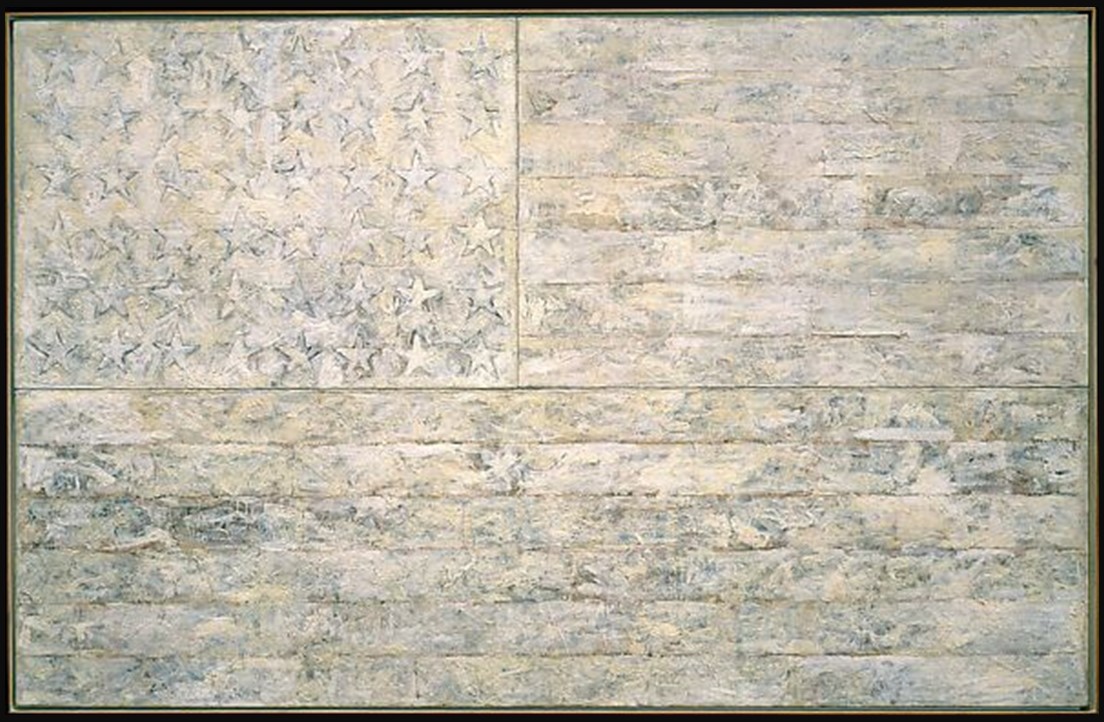
White Flag, 1955, Encaustic, Oil, Newsprint, and Charcoal on Canvas, 198.9 × 306.7 cm, the MET, NY, USA https://www.metmuseum.org/art/collection/search/487065
According to the Metropolitan Museum of Art experts… During the 1950s and 1960s, Johns frequently appropriated well-known images such as targets, maps, and flags—in his words, “things the mind already knows.” White Flag is part of Jasper Johns’s famous flag series, which he began in 1954. In this rendering, he drains this iconic subject of its characteristic red, white, and blue coloration, leaving it to loom, ghostlike. The painting’s bleached appearance and composite layered form make the familiar image strange. By challenging our understanding of what constitutes a national symbol and complicating our relationship to this highly charged American image, it speaks powerfully, if ambiguously, to the issue of national identity. https://www.metmuseum.org/art/collection/search/487065
Jasper Johns, born on May 15, 1930, in Augusta, Georgia, is a prominent American artist renowned for his pivotal role in developing postwar American art, particularly in the genres of Abstract Expressionism and Neo-Dada. His contributions extend beyond painting; he has also worked extensively in printmaking, sculpture, and collage. His methodical approach and use of encaustic—a technique involving pigment mixed with hot wax—imbue his works with a textured, tactile quality that invites close inspection. Over the decades, Jasper Johns has received numerous accolades, including the Presidential Medal of Freedom, and his works are featured in major museums and collections worldwide. His influence on contemporary art profoundly inspires generations of artists to explore the intersections of reality, perception, and artistic expression.
Jasper Johns’ paintings of American Flags emerged in the mid-1950s, a period when he sought to challenge and redefine the boundaries of artistic expression. The concept originated from a dream Johns had in 1954, in which he envisioned himself painting a large American flag. This dream inspired him to create his first flag painting using encaustic, a technique involving heated beeswax mixed with coloured pigments. This method allowed him to build up layers of texture and depth, emphasizing the materiality of the painting itself. His “Flag” (1954-55) became a groundbreaking work, as it juxtaposed a familiar symbol with a complex, tactile artistic process. By selecting an iconic image like the American flag, Johns deliberately chose a subject that was instantly recognizable, yet ripe for reinterpretation, encouraging viewers to see it in a new light.
The artistic value of Jasper Johns’ flag paintings lies in their ability to challenge conventional perspectives on representation and abstraction. These works are celebrated for their conceptual depth and technical innovation. By transforming a common national symbol into a subject of fine art, Johns questioned the distinction between “high” art and popular culture. The encaustic technique he employed added a richly textured surface, creating a sense of depth and solidity that contrasted with the flat, symbolic nature of the flag. This interplay between the literal and the abstract invites viewers to reconsider the flag’s meaning and significance. Moreover, Johns’ flags are seen as a precursor to the Pop Art movement, influencing artists like Andy Warhol and Roy Lichtenstein. His work paved the way for future explorations of everyday objects in art, highlighting the potential for ordinary symbols to carry complex, layered meanings.
White Flag (1955) is a monumental work in the artist’s oeuvre and a significant piece in the history of contemporary art. Created shortly after his initial Flag painting, ‘White Flag’ represents Johns’ continued exploration of the American flag as an artistic subject. The painting is notable for its size and its use of encaustic, which Johns adopted to impart a textured, layered quality to his works. ‘White Flag’ was the first of Johns’ flag paintings to be rendered in a monochromatic palette, stripping away the traditional red, white, and blue colours. This alteration transformed the flag from a patriotic symbol into a more ambiguous, abstract form. By presenting the flag in white, Johns opened up a range of interpretations, inviting viewers to consider themes of purity, surrender, and neutrality.
The artistic value of ‘White Flag’ lies in its innovative approach to both medium and meaning. The use of encaustic gives the painting a rich, tactile surface, emphasizing the physicality of the flag and the artist’s hand in its creation. This technique also allows for subtle variations in texture and tone, creating a complex visual experience despite the limited colour palette. The monochromatic scheme forces viewers to focus on the structure and form of the flag itself, rather than its usual symbolic content. ‘White Flag’ exemplifies Johns’ ability to transform a familiar icon into a subject for deep artistic investigation. It challenges the viewer to see beyond the conventional associations of the American flag, encouraging a more nuanced and contemplative engagement with the image. This work, along with Johns’ other flag paintings, has had a profound influence on contemporary art, paving the way for future artists to explore and deconstruct cultural symbols in innovative ways.
For a PowerPoint, titled 10 Works of Art by Jasper Johns, please… Check HERE!